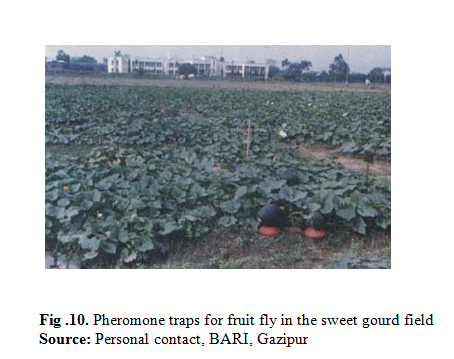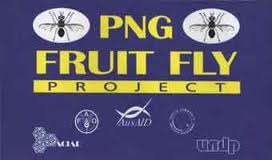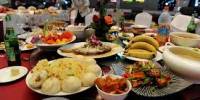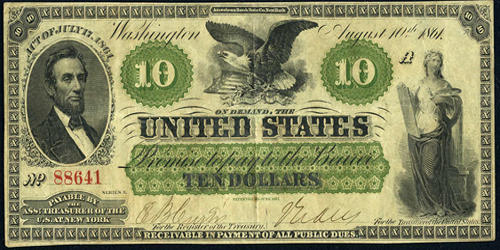INTRODUCTION
Bangladesh is predominantly an agriculture based country. But it has a huge deficit in vegetable production. The annual production of vegetables is only 2.5 million tons, including potato and sweet potato (Anon.1993).The optimum requirement of vegetable for a full grown person is 285g but in Bangladesh it is only 32g (Hossain et al. 1990; and Ramphall and Gill 1990).
Vegetables are not equally produced throughout the year in the country. Most of the important vegetables are produced in winter. And the production in summer is tremendously low (Anon. 1993). In summer the major vegetables grown are cucurbits. As a result, cucurbitaceous vegetable plays an important role to supplement this shortage during the lag period (Rashid 1993). A large number of cucurbit vegetables, viz., bottle gourd, bitter gourd, sweet gourd, snake gourd, white gourd, ridge gourd, sponge gourd, kakrol, cucumber etc. are grown in Bangladesh.
Cucurbits are infested by several insect pests which are considered to be the significant obstacles for economic production. Among them, cucurbit fruit fly is the serious pest responsible for considerable damage of cucurbits (Alam 1969, Butani and Jotwani 1984).
The cucurbit fruit fly Bactrocera cucurbitae can attack about 16 different types of cucurbit crops. Although the rate of attack varies among the crop, infestation reduced both the yield and quality of the cucurbit fruits. Yield losses due to fruit fly infestation vary from 19.19 to 69.96 percent in different fruits and vegetables (Kabir et al. 1991) and the damage caused by fruit fly is the most serious in melon which may be up to 100 percent (Atwal 1993).
Due to its nature of infestation, it is very difficult to control the pest. A cluster method have been developed and suggested by Kapoor (1993) to control these pests. Among all these methods, the chemical control method is still popular to the Bangladeshi farmers because of its quick and visible results.
The increasing use of synthetic insecticides has led to a number of problems such as development of resistance to insecticides in some insect pests, high insecticide residues in market produce, resurgence or increased infestation by some insect species due to the destruction of natural predators and parasitoids, changing pest status of mites and other minor insect pests, ecological imbalance and danger to health of the pesticide applicator.
Considering the alarming consequences of pesticide usage and residual effect on the environment, pragmatic programme is now needed worldwide to minimize the dependency on insecticides without hampering crop production. IPM, undoubtedly since last few years has been a much talked scientific phenomenon in Bangladesh, particularly in the area of the agricultural policy makers.
Approaches of IPM is thought to be the best and very effective in many countries of the world as well as in Bangladesh, to control vegetable pests. In the contemporary usage, IPM is not limited to deal with pesticides and management; in fact IPM has a holistic approach to crop production based on sound ecological understanding and in this sense, IPM could even be termed as Eco-friendly pest management. “IPM targets changing of the farmer’s practices toward growing a healthy crop and increasing the farm output and farmers income on a sustainable basis while improving the environment and community health”.
In view of the above facts, the main focus of this paper is lying in the following specific objectives:
- To determine the way how to reduce the chemical pesticides for the management of cucurbit fruit fly.
- To assess the alternative use of toxic chemicals for the management of cucurbit fruit fly.
- To highlight the establishment of an environmentally safe control measure in cucurbit crops.
To identify some approaches for the management of cucurbit fruit fly.
MATERIALS AND METHODS
This seminar paper is exclusively a review paper and has been prepared by reviewing various books, journals, workshop/symposium, proceedings, reports, publications, thesis etc. with the help of library facilities of Bangabandhu Sheikh Mujibur Rahman Agricultural University (BSMRAU), Bangladesh Agricultural Research council (BARC), Bangladesh Agricultural Research Institute (BARI), Bangladesh Rice Research Institute (BRRI) etc. Data has been collected from secondary sources and in consultation with resource personnel.
RESULTS AND DISCUSSION
Fruit fly is the most damaging pest of cucurbits and considered as an important obstacle for economic production of these crops. The use of alternative to toxic chemicals for the management of cucurbit fruit fly are as follows:
Management of fruit fly by bagging
This method has been tried with the use of colorless polythene bags having a few holes made with an ordinary pin (Narayer and Batra, 1960).
An experiment was conducted by Aktaruzzamn et al. (1999) on suppressing fruit fly infestation by bagging cucumber at different days after anthesis. They observed the following results:-
Percent infestation of fruit fly by number
The mean of all stages of fruit fly infestation was significantly lower (5.53%) in T2 where bagging of fruits at 3 days after anthesis was made and retained for 5 days (Table 1). Fruit fly infestation under T1, T3, and T4 comprising bagging of fruits at 1, 5, and 7 days after anthesis and retained for 3, 7 and 7 days, respectively were statistically similar. These infestations were also statistically comparable to those of untreated control (Table 1). Here the best performance in suppressing fruit fly was obtained from treatment involving bagging of fruits at 3 days after anthesis and retaining the bag for 5 days. Table 1 also shows that treatment T2 comprising fruit bagging at 3 days after anthesis and left for 5 days made statistically significant suppression of fruit fly thorough the initial, early, mid and late fruiting stages.
Table 1. Effect of different bagging on fruit infestation by number in cucumber grown in
1997-98 cropping season at BSMRAU, Gazipur, Bangladesh
| Treatment | Infested fruit (%) | ||||
| Fruit initiation stage | Early fruiting stage | Mid fruiting stage | Late fruiting stage | Mean of all stages | |
| Bagging at 1 DAA for 3 days (T1) | 38.54 a | 24.86a
| 9.84ab | 33.75a
| 26.75a
|
| Bagging at 3 DAA for 5 days (T2) | 6.97b | 4.93b | 7.42ab
| 2.80b
| 5.53b
|
| Bagging at 5 DAA for 7 days (T3) | 28.72a | 18.60a | 15.15a | 29.29a | 22.92a |
| Bagging at 7 DAA for 7 days (T4) | 26.25b | 19.56a | 10.33ab | 19.24a | 18.25a |
| Untreated control (T5) | 31.20a | 25.53a
| 14.39a | 5.73b | 19.21a |
Means followed by similar letter in a column are statistically similar at 5% level by DMRT, DAA = Day(s) after anthesis.
Source: Akhtaruzzaman et al., 1999
Percent fruit infestation by weight
Significantly the lowest percent of fruit infestation by weight was obtained in fruits harvested from T2treatment comprising bagging of fruits at 3 days after anthesis and continued for 5 days (Table 2). The values of fruit infestation by weight under T1, T3, T4 and untreated control plots were statistically comparable to each other. Similarly trend of fruit infestation by weight was observed in case of fruits harvested at early fruiting stage (Table 2).
At fruit initiation stage significantly minimum fruit infestation by weight was obtained under T2 treatment. At this stage there was no significant difference in fruit infestation by weight under T1, T3 and T5. At mid-fruiting stage the efficacy of T1, T3 and T4 on reduction of infested fruit by weight was not satisfactory and percent of infested fruit by weight under these treatments was not statistically different from that of untreated control (T5). At late fruiting stage the percent of infested fruits by weight under T2, T4, and T5 were statistically similar as compared with T1 and T3 (Table 2). Therefore, this study indicated that the treatment T2 where bagging of fruits was done at 3 days after anthesis and maintained for 5 days reduced the fruit infestation by weight significantly throughout the whole reproductive stages (Table 2).
Table 2. Effect of different bagging on percent fruit infestation by weight in cucumber grown in997-98 cropping season at BSMRAU, Gazipur, Bangladesh
Treatment | Infested fruit by weight (%) | ||||
| Fruit initiation stage | Early fruiting stage | Mid fruiting stage | Late fruiting stage | Mean of all stages | |
| Bagging at 1 DAA for 3 days (T1) | 18.73a | 10.24a | 4.40ab | 19.65a | 13.26a |
| Bagging at 3 DAA for 5 days (T2) | 2.56c | 1.68b | 2.15b | 1.10b | 1.87b |
| Bagging at 5 DAA for 7 days (T3) | 11.57ab | 6.60a | 6.84ab | 15.15a | 10.13a |
| Bagging at 7 DAA for 7 days (T4) | 8.25bc | 7.11a | 4.67ab | 6.29b | 6.58a |
| Untreated control (T5) | 13.29ab | 9.09a | 9.71a | 3.27b | 8.84a |
Means followed by similar letter in a column are statistically similar at 5%lrvel by DMRT
DAA= Day(s) after anthesis.
Source: Akhtaruzzaman et al., 1999
Weight reduction per fruit
The weight reduction per fruit was determined on the basis of average fruit weight at each of the four reproductive stages of cucumber. The mean value of weight reduction per fruit ( %) recorded under T2 (bagging of fruits at 3 days after anthesis and kept for 5 days) was statistically significant. The differences in reduction of fruit fly infested fruits under T1, T3, T4 and T5 were not significant (Table 3). Weight reduction per fruit recorded at fruit initiation, early fruiting and late fruiting stages under T2 were also minimal and the trend of reduction was similar to mean values of all stages (Table 3). This study indicates that bagging of fruits at 3 days after anthesis and left for 5 days produced the lowest value of weight reduction per fruit.
Table 3. Effect of different bagging on weight reduction per fruit at different reproductive
stages in cucumber grown in 1997-98 cropping season at BSMRAU, Gazipur, Bangladesh
Treatment | Weight reduction per fruit (%) | ||||
Fruit initiation stage | Early fruiting stage | Mid fruiting stage | Late fruiting stage | Mean of all stages | |
| Bagging at 1 DAA for 3 days (T1) | 63.57a | 68.86a | 57.92a | 52.65a | 60.57a |
| Bagging at 3 DAA for 5 days (T2) | 38.48b | 35.42b | 56.18a | 19.24b | 37.33b |
| Bagging at 5 DAA for 7 days (T3) | 68.66a | 68.87a | 66.81a | 52.84a | 64.30a |
| Bagging at 7 DAA for 7 days (T4) | 74.84a | 68.35a | 43.44b | 56.38a | 60.66a |
| Untreated control(T5) | 74.95a | 70.03a | 40.29b | 37.63ab | 55.73a |
Means followed by similar letter in a column are statistically similar at 5%lrvel by DMRT
DAA= Day(s) after anthesis.
Source: Akhtaruzzaman et al., 1999
Management of fruit fly by Cultural & mechanical control
Several authors highly advocated hand picking of infested fruits to reduce fruit fly damage on cucurbit vegetables. Nasiruddin & Karim (1992) recommended collection and destruction of infested fruits with larvae inside for reducing fruits fly population on snake gourd. Mitchell and Soul (1990) reported that this practice is widely used in USA for suppressing Mediterranean fruit fly Ceratitis capitata. Atwal (1993) suggested such mechanical control measures in farmer’s fields as normal practice for effective control against this pest in India.
Several authors recommended field sanitation for suppression of fruit fly population in many countries (Agarwal et al. 1987; Mitchell and Saul 1990; Smith 1992).
Percent fruit fly infestation by number
An experiment was conducted by Alam et al. (1999) on effectiveness of some mechanical & cultural methods for suppressing fruit fly in cucumber. They observed the following results:
The percent fruit fly infestation under different treatments were presented in Table 4. At mid fruiting stage, the differences in percent infested fruits under all treatments including untreated control were not significant (P=0.05). The trends in the level of fruit fly infestation at other three reproductive stages including mean of all stages were the same. The mean percent of infested fruits of all stages from mechanical control (9.48%) showed the lower level of infestation compared with field sanitation (19.18%) and control (24.10%).
Table 4. Effect of cultural and mechanical practice on infestation of fruit fly in cucumber grown in 1997-98 cropping season at BSMRAU, Gazipur, Bangladesh
Treatment | Fruit infestation by number (%) | ||||
Fruit initiation stage | Early fruiting stage | Mid fruiting stage | Late fruiting stage | Mean of all stages | |
Hand picking of infested fruits | 13.55b | 6.62b | 12.75a | 5.03b | 9.48b |
Field sanitation | 22.27a | 15.34a | 15.64a | 22.97a | 19.18a |
Untreated control | 26.96a | 16.84a | 19.02a | 34.82a | 24.10a |
Figures followed by similar letter in a column are statistically similar at 5 percent level by DMRT
Source: Alam et al., 1999
Percent fruit infestation by weight
The infested fruits at each harvest were weighed and added for each reproductive stage and presented in Table 5. A positive relation was evident between the overall fruit fly infestation by number and fruit infestation by weight for various treatments and reproductive stages. In case of mean of all stages the highest fruit infestation by weight was obtained in fruits harvested from untreated control (8.78%) plots followed by sanitation (6.12%) and hand picking (3.89%). Significantly the lowest weight of infested fruit was obtained in the fruits harvested from mechanically controlled plots (Table 5).
Table 5. Effect of cultural and mechanical practices on fruit infestation by weight in
cucumber grown in 1997-98 cropping season at BSMRAU, Gazipur, Bangladesh
Treatment | Fruit infestation by weight (%) | ||||
Fruit initiation stage | Early fruiting stage | Mid fruiting stage | Late fruiting stage | Mean of all stages | |
Hand picking of infested fruits | 5.76b | 4.08b | 4.13a | 1.93b | 3.89b |
Field sanitation | 9.17ab | 6.72ab | 3.94a | 4.66ab | 6.12ab |
Untreated control | 12.50a | 9.50a | 4.34a | 8.76a | 8.78a |
Figures followed by similar letter in a column are statistically similar at 5 percent level by DMRT,
Source: Alam et al., 1999
Percent weight reduction per fruit
The percent weight reduction per fruit due to fruit fly infestation at different reproductive stages is presented in Table 6. The mean value of weight reduction per fruit ranged from 34.36 to 76.87%. Significantly the lowest weight reduction per fruit was obtained in cucumber harvested from mechanically controlled plots which was statistically similar to that from Malathion treated plots. The highest weight reduction was observed in untreated plots which was similar to those from cultural control plots (Table 6).
Table 6. Effect of cultural and mechanical practices on weight reduction per fruit at various
reproductive stages of cucumber grown in 1997-98 cropping season at BSMRAU, Gazipur, Bangladesh
Treatment | Weight reduction per fruit (%) | ||||
Fruit initiation stage | Early fruiting stage | Mid fruiting stage | Late fruiting stage | Mean of all stages | |
Hand picking of infested fruits | 43.50ab | 37.76c | 37.76b | 18.43c | 34.36b |
Field sanitation | 66.62a | 72.01ab | 72.01a | 87.79a | 74.61a |
Cover spray with Malathion | 31.73b | 42.81bc | 65.56ab | 53.26b | 48.34b |
Untreated control | 61.79a | 82.02a | 82.02a | 81.66a | 76.87a |
Figures followed by similar letter in a column are statistically similar at 5 percent level by DMRT
Source: Alam et al., 1999
Management of fruit fly by pheromone and indigenous bait traps
Bait traps
A poisoned bait gave good control of fruit flies (Steiner et al. 1998). An experiment was conducted by Nasiruddin and karim (1992) on the evaluation of potential control measure for fruit fly, Bactrocera (Dacus) cucurbitae, in snake gourd. They observed that fruit fly infestation rates in snake gourd fruits in bait trap treatment plot was 4.9% against 22.5% infested fruits in the control plot which differed significantly (P<0.05; Table 4) . They also observed that 78.4% reduction of fruit infestation over the infestation rate in the control (Table 7).
Table 7. Effect of bait trap in reducing the fruit fly, Bactrocera (Dacus) cucurbitae, attacking snake
gourd in kharif, 1990 at Comilla
Treatment | Total fruits harvested (no.) | Infested fruits | Reduction over control (%) | |
No. | % | |||
Bait trap (0.5g Dipterex 80SP/100g sweet gourd mash) | 247 | 12 | 4.86b | 78.38 |
Control | 218 | 49 | 22.48a | _ |
Means followed by same letter are not significantly different (P<0.05, DMRT). No. of flies trap=260 males +411 females; male: female sex ratio = 1:1.58
Source: Nasiruddin and Karim, 1992

Comparative effectiveness of pheromone dispensers and bait traps
An experiment was conducted on comparative effectiveness of various sex pheromone dispensers and mashed sweet gourd bait traps for fruit fly control (Anon. 1999-2000). The following results were observed:
Fruit fly capture in pheromone dispensers and the bait trap differed significantly. Cuelure +methyl eugenol + naled captured significantly more fruit flies (269) than
any other treatment. It was followed by cuelure liquid +5% dibrom (185) and 92% cuelure +8% naled (172). Catches in mashed sweet gourd and methyl eugenol + naled were the lowest, 86 and 18, respectively. The noteworthy feature of the mashed sweet gourd trap was that it captured both male (25) and female (61) fruit flies, indicating its biological impact in the management of cucurbit fruit fly. On the contrary, all the pheromone traps captured only males (Table 8 and Fig.2).
Table 8: Fruit fly capture in pheromone dispensers and mashed sweet gourd traps, BARI
farm, February to April, 2000
Treatments | Total catch of fruit fly | ||
Male | Female | Total | |
92% Cuelure +8% Naled | 172 | 0 | 172b |
Methyl eugenol+ Naled | 18 | 0
| 18c |
Cuelure+ methyl eugenol+ Naled | 0 | 0 | 269a |
Cuelure liquid+ 5% Dibrom | 185 | 0 | 185b |
Mashed sweet gourd trap | 25 | 61 | 86c |
Figures in each column are averages of four replications; figures followed by the same letter are not significantly different
Source: Anonymous, 2000
Efficacy of pheromone and indigenous bait trap for fruit fly control
The fruit fly capture can create a negative impact on fruit infestation. The higher the fruit fly capture the lesser was the fruit infestation and higher was the yield. The pheromone traps captured the highest number of flies, more then 20 times higher than that captured in indigenous mashed sweet gourd traps, and effected 5 times less fruit infestation than the untreated fields. The mashed sweet gourd baits, although captured lower number of fruit flies than the pheromone traps, significantly lessened fruit infestation and produced 35% more yield than the untreated control plot. Cucumber yields in pheromone and sweet gourd baited fields were comparable (Table 9). The results suggested that pheromone and indigenous bait traps have great potential for use as control techniques for fruit fly IPM.
Table 9: Fruit fly capture, yield and fruit infestation in cucumber. Kashimpur area, summer season, 2000
Treatment | Fruit fly captured (No.) | Total yield (kg/plot) | Infested fruit/plot (kg) | Infested fruit (%) | ||
Male | Female | Total | ||||
Mashed sweet gourd | 86 | 114 | 200 | 211 | 25 | 11.9 |
Cuelure+5%dibrom | 4122 | 0 | 4122 | 235 | 12.5 | 5.4 |
Untreated control | 0 | 0 | 0 | 156 | 42 | 27.1 |
Source: Anonymous, 2001
Fruit fly management in cucumber
An experiment was conducted (Anon. 2001) on management of cucurbit fruit fly, Bactrocera cucurbitae, in cucumber and sweet gourd by using pheromone and indigenous bait traps and its effect on year- round incidence of fruit fly. They observed the following result:
During the summer season of 2000 and 2001, the higher the fruit fly capture the lesser was the fruit infestation and higher was the yield. Only male fruit flies were attracted to cuelure bait traps and the number of fruit flies captured in cuelure bait traps was 18 and 5 times higher respectively, in 2000 and 2001 than captured in MSG bait traps (Fig.3 and Fig.4) and the effect of fruit fly catches was reflected in 500% and 300% smaller fruit infestation in cuelure treated fields as compared to the untreated field (Fig.5 and Fig.6).The number of fruit flies captured in cuelure treated fields was about 3 times lower in 2001 than that of 2000, indicating that continual bait trapping in the area might have created a negative effect on fruit fly population. The MSG bait trap, although captured lower number of fruit flies than the cuelure traps, significantly reduced fruit fly infestation and yielded 35% and 109% more yields, respectively, in 2000 and 2001 than the untreated control plots. Cucumber yields between cuelure and MSG treated fields in 2000 and between MSG and cuelure + MSG fields did not vary (Fig.5 and Fig.6).The results revealed that joint treatment of cuelure + MSG has a greater promise as a technique for fruit fly control in cucurbit.
The results of 2001 showed that cucumber in MSG baited fields had the lowest fruit infestation. But the lowest damage occurred in fields baited with cuelure+ MSG, followed by cuelure and MSG, whereas the highest damage recovery (infested but marketable ) was obtained in cuelure and cuelure +MSG baited fields (Fig.7 and Fig8). The recovery of damage suggested that the fruits were stung by the flies without infesting their eggs or the eggs were unfertilized.
Effect of mass trapping on fruit fly incidence
The cucurbit fruit flies were prevalent in the field throughout the year and they were attracted continually to cuelure baited traps even when there was no cucurbit crop in the field or in the neighborhood. MSG baited traps, on the other hand, captured the fruit flies only in presence of cucurbit crops, but not during fallow periods. As usual, the fruit fly catches in cuelure baited traps were 5-10 times higher than that caught in MSG traps. The result strongly suggests that the pheromone cuelure possesses strong luring capacity to attract fruit flies from a wide distance, whereas MSG is effective in attracting only the fruit flies which are present within a cucurbit crop. The pattern of fly catches in year 2000 and 2001 shows that continuous mass trapping has probably reduced the fruit fly population in the area
Fig. 9. Fruit fly catches in cuelure and MSG bait traps in 2000 & 2001, Kashimpur
Source: Anonymous, 2001


Management of fruit fly by IPM Package(s)
The effective control of fruit fly in cucurbit demands some new approaches which don’t rely only on chemicals, reduce the use of chemicals, safeguard the environment and ensure economical and social acceptance. This might lead to develop the IPM package(s) against this pest.
Percent Fruit Infestation by Number
An effectiveness of various IPM packages for the management of fruit fly on cucumber was reported by Akhtaruzzaman (1999). He observed the following result:
The mean values of infestation at all stages of reproduction under IPM package 3 (Cypermethrin applied at15 days intervals + bagging fruits at 3 DAA and left for 5 days + bait trap) was lower (3.54%) but statistically similar to that of package 2(Cypermethrin at 15 days intervals + bait spray with Malathion + molasses + bait trap) and package 4 (hand picking of infested fruits + bait trap). The rates of infestation of fruits harvested from plots subjected to package 1 (hand picking of infested fruit + bagging of fruits at 3 DAA and left for 5 days) and package 5 (hand picking of infested fruits+ bait trap) were significantly higher (Table-10).
Table10. Effect of IPM Package(s) on fruit infestation by number in cucumber grown in 1998-99 cropping season at BSMRAU, Gazipur, Bangladesh
Treatment | Infested fruit (%) | ||||
Fruit initiation stage | Early fruiting stage | Mid fruiting stage | Late fruiting stage | Mean of all stages | |
Package 1 | 8.91b | 7.83b | 7.48b | 8.53b | 8.19b |
Package 2 | 4.54c | 3.39c | 3.13c | 3.70c | 3.69c |
Package 3 | 3.15c | 4.40b | 3.00c | 3.59c | 3.54c |
Package 4 | 3.96c | 4.81b | 2.82c | 5.02c | 4.15c |
Package5 | 11.75b | 9.14b | 6.54b | 8.98b | 9.10b |
Control | 30.08a | 26.43a | 24.49a | 30.02a | 27.76a |
Means followed by similar letter in a column are statistically similar at 5% level by DMRT
Package 1: Hand picking of infested fruit + bagging of fruits at 3 days after anthesis (DAA)
for 5 days.
Package 2: Cypermethrin 15 days interval + bait spray with Malathion and molasses + bait
trap.
Package 3: Cypermethrin at15 days interval + bagging fruits at 3 DAA for 5 days + bait trap.
Package 4: Hand picking of infested fruits+ bait spray with Malathion and molasses.
Package 5: Hand picking of infested fruits+ bait trap.
Source: Akhtaruzzaman, 1999
Fruit yield
Effect of different IPM packages on yield was evaluated in terms of total, healthy and infested fruit yield obtained during the entire reproductive period of the crop. The results thus obtained including the percent increase/ decrease of yield over control is presented in Table 11.
In this study, the total fruit yield was significantly higher (10.49 t/ha) in the plots treated with the components of IPM package 3 (Cypermethrin at15 days interval + bagging fruits at 3 DAA for 5 days + bait trap).
Table11. Effect of IPM Package(s) on the increase/decrease of yield over control by the infestation of fruit fly on cucumber grown in 1998-99 cropping season at BSMRAU, Gazipur, Bangladesh
Treatment | Healthy yield | Infested yield | Total yield | |||
t/ha | Increase over control (%) | t/ha | Decrease over control (%) | t/ha | Increase over control (%) | |
Package1 | 9.11b | 50.33 | 0.21b | 65.00 | 9.32b | 39.94 |
Package2 | 9.55a | 57.59 | 0.17bc | 71.67 | 9.12a | 45.95 |
Package 3 | 10.35a | 70.79 | 0.14c | 76.67 | 10.49a | 57.50 |
Package 4 | 9.27b | 52.97 | 0.14c | 76.67 | 9.41b | 41.29 |
Package 5 | 9.13b | 50.66 | 0.25b | 58.33 | 9.38b | 40.84 |
control | 6.06c | – | 0.60a | – | 6.66c | – |
Means followed by similar letter in a column are statistically similar at 5%lrvel by DMRT
Package 1: Hand picking of infested fruit + bagging of fruits at 3 days after anthesis (DAA)
for 5 days.
Package 2: Cypermethrin 15 days interval + bait spray with Malathion and molasses + bait
trap.
Package 3: Cypermethrin at15 days interval + bagging fruits at 3 DAA for 5 days + bait trap.
Package 4: Hand picking of infested fruits+ bait spray with Malathion and molasses.
Package 5: Hand picking of infested fruits+ bait trap.
Source: Akhtaruzzaman, 1999
Management of fruit fly by color ribbon
Insects have been shown to be capable of perceiving color and there is considerable variation in terms of wavelength perceived by different insect (Atkins 1978).
Fruit fly infestation by number
An experiment was conducted by Rahman et al. (2002) on effectiveness of different color ribbons for suppressing fruit fly (Bactrocera cucurbitae Coq.) infestation on bitter gourd in net house. They observed the following results:
The percent fruit infestation was statistically higher (50.96%) in untreated control plot (T5)and statistically lower (27.67%) in silver color ribbon treated plot (Table 12). Table 12 also showed that, the higher and lower percent reduction over control by number was obtained from silver color ribbon (T4) and yellow color ribbon (T1) treated plots, respectively.
Table 12. Effect of colored ribbons on bitter gourd fruit infestation and their reduction over
control by number for total reproductive stage in the net house (1999-2000 rabi season) at BSMRAU, Gazipur, Bangladesh
Treatment | Fruit infestation and their reduction over control by number | |
| Number (%) | Reduction over control (%) | |
| T1 | 34.71b | 31.89 |
T2 | 33.42bc | 34.42 |
T3 | 28.50c | 44.07 |
T4 | 27.67c | 45.70 |
T5 | 50.96a | – |
In a column, means followed by same latter(s) are statistically similar at 5%level by LSD
T1= Yellow color ribbon
T2= Red color ribbon
T3= Indigo color ribbon
T4= Silver color ribbon
T5= Untreated control
Source: Rahman, 2002
Fruit fly infestation by weight
In net house the effects of yellow, red, indigo and silver color ribbons on fruit fly infestation by weight on bitter gourd are presented in Table 13. Statistically higher rate of infestation (%)was observed in untreated control plot. The lowest fruit infestation by weight was obtained from the silver color ribbon treated plot. Percent weight reduction per fruit due to fruit fly infestation calculated for the entire reproductive stages and its reduction over control are presented in Table 13.The over all weight reduction per fruit ranged from 35.19 % to 52.27%.The lowest weight reduction per fruit was obtained from T4 treated plot, but it was statistically similar to T3 treated plot. The highest weight reduction occurred in fruits of untreated control plot, which was statistically similar to T2 treated plot. Weight reduction over control was higher in T4 treated plot and lower in T2 treated plot (Table 13).
Table13. Effect of colored ribbons on weight reduction per fruit and reduction over control
for reproductive stages in net house on bitter gourd in earthen plots (1999-2000 rabi season) at BSMRAU, Gazipur, Bangladesh
Treatment | Weight reduction (%) over control calculated during 1999-2000 rabi season for total reproductive stages for | |
Wt. Reduction per fruit (%) | Wt. Reduction over control (%) | |
| T1 | 43.04bc | 17.66 |
T2 | 49.00ab | 6.26 |
T3 | 38.21cd | 26.90 |
T4 | 35.19d | 32.64 |
T5 | 52.27a | – |
In a column, means followed by same latter(s) are statistically similar at 5% level by LSD
T1= Yellow color ribbon
T2= Red color ribbon
T3= Indigo color ribbon
T4= Silver color ribbon
T5= Untreated control
Source: Rahman, 2002

SUMMARY
Different technologies were used as the alternative technique of toxic chemicals, such as cultural and mechanical practices, bait traps, pheromone, color ribbon and IPM packages. When percent infestation of fruit, percent infestation by weight, weight reduction per fruit were studied by bagging, the best performance in suppressing fruit fly was obtained from treatment involving bagging of fruit at 3 days after anthesis and retaining the bag for 5 days. Percent fruit infestation by number, percent fruit fly infestation by weight and percent weight reduction per fruit were studied by mechanical and cultural practices. From this study, the best result was the hand picking of infested fruits. Total fruits harvested, number and percent of infested fruits and reduction over control were studied by bait trap and untreated control. Bait trap showed the best performance than untreated control plot. Again, when studied with pheromone and mashed sweet gourd trap, pheromone captured higher number of fruit fly than mashed sweet gourd trap. But pheromone captured only male fruit fly and mashed sweet gourd trap captured both male and female fruit fly. The higher the fruit fly captured the lesser was the fruit infestation and the higher was yield. Percent fruit fly infestation by number and fruit yield were studied by IPM packages. The best performance was package 3 (Cypermethrin 15 days interval +bagging fruits at 3 DAA for 5 days +bait trap). When fruit fly infestation by number and by weight were studied by color ribbon, silver ribbon showed the best performance for fruit fly control.
CONCLUSION
On the basis of the findings of the present study, the following conclusion may be drawn:
- Bagging of individual cucumber at 3 days after anthesis (DAA) and left for 5 days significantly reduced the fruit fly infestation compared to bagging at 1, 5, 7 DAA and left for 3, 7, and 7 days respectively.
- As an IPM package Cypermethrin @ 0.5 ml/liter of water at 15 days intervals +bagging of fruits at 3 DAA and kept for 5 days + bait trap might be considered as the best package in reducing fruit infestation and increasing yield. However, in economic and environmental point of view an IPM package composed of hand picking of infested fruits + bait spray with Malathion plus molassas may be used.
- Pheromone and indigenous bait traps can be effectively used for fruit fly capture which proved to be potentially useful for reduced fruit injury and higher yields of cucurbit crops.
- The female fruit fly showed preference for yellow, red and to a lesser extent for indigo color ribbon, while silver ribbons elicited a very low response. Therefore, the silver color ribbon may be chosen as one of the component of IPM package against fruit fly to encourage environment friendly fruit fly management.
RECOMMENDATIONS
The comparative evaluation of different methods against fruit fly revealed that, bagging of fruits at 3 DAA and retained for 5 days, bait trap and pheromone trap may be recommended for the management of cucurbit fruit fly. However, further experiments on the integration of the above approaches would be extremely helpful to find out the most appropriate package against this pest.
















